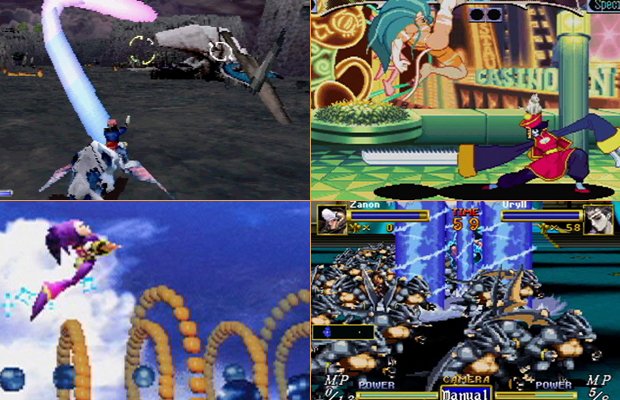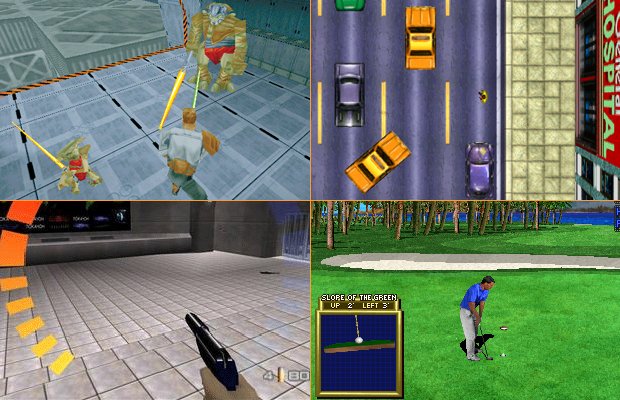ClassicRadar: The ten greatest years in videogame history
We calculate the best 120 months of gaming. Which do you remember?
1996

Though we think of arcades as on a downward spiral by 1996, they weren't dying without a fight. Area 51 was one of the last great gun games, San Francsico Rush's addictive racing won fans, and Metal Slug launched a 2D dynasty. Whether you preferred the 3D fighting of Virtua Fighter 3 and its mind-blowing graphics or the polish of Street Fighter Alpha 2 - which also made it out on PlayStation and Saturn this year - you had a place to drop your quarters.

The Saturn gave its all in the face of Sony's onslaught, producing a pile of memorable games: Dragon Force is still talked about in hushed tones by strategy addicts, while Sega took a left turn with NiGHTS into dreams..., a thoroughly beautiful and inventive actioner. Panzer Dragoon II: Zwei delivered great, 3D shooting action, while Night Warriors: Darkstalkers' Revenge was another of Capcom's memorable contributions to Saturn fighting fans.

The PlayStation began to hit its stride in its second year, offering up its first slate of fully-formed sequels: Wipeout XL was near-perfect futuristic racing while Twisted Metal 2 got car combat right. The often-overlooked Jumping Flash! 2 proved even more engaging and adorable than the original... shame there's no sequel in sight 10 years later. That's not to say that sequels were it: Tomb Raider and Resident Evil are 1996's twin stars, each defining the PlayStation era in its own way.
Of course, the Nintendo 64, with the superlative Super Mario 64, appeared in 1996. The game redefined a series that had created the very fabric of console games in its first installment, inspiring another wave of imitators and innovators in its wake. Pilotwings 64 was an early standout as well.

The PC, of course, kept going strong. Id software, the creators of the Doom series, shot off their first full-3D salvo with Quake. Then, Sid Meier's Civilization II drove strategy fans into a new realm of ecstasy, and if they couldn't get enough, Master of Orion II offered a galactic civilization to nurture. Duke Nukem 3D wasn't the first game in the series, but its leap into 3D defined it - and an attitude we still see plenty of today.
1997

Let's just drop one name right off the bat… Final Fantasy VII.
There aremore, of course -though some gamers won't need it. Tomb Raider II continued the lovely Lara Croft's spelunking with more polished gameplay - this was arguably the series' apogee. And a Nintendo 64 first-person shooter called GoldenEye 007 turned out so well, some stubborn gamers still call it the bestconsole first-person shooterof all time.
Weekly digests, tales from the communities you love, and more

Nintendo also launched shooter Star Fox 64 into the great beyond, and burned rubber with Mario Kart 64.On PlayStation, the falling blocks-riddled Super Puzzle Fighter II Turbo actually managed to make sweaty martial artists cute, and Castlevania: Symphony of the Night clarified that 2D action games would never die - they would just become undead legends full of bats and vampires.

PC players, however, were all about the 3D gaming - specifically the type that began with the word Quake and ended with the roman numeral II. Fellowshooter Star Wars: Jedi Knight - Dark Forces II commanded astrong presence, and Star Wars: X-Wing vs TIE Fighterlaunched the fight into the frigid, black vacuum of space. Age of Empires helped us rule all that we surveyed, and Dungeon Keeper and Carmageddon helped us with our sadistic frustrations when that mantle of leadership got too stifling. Of course, the bombastic RTS Total Annihilation and post-apocalyptic RPG Fallout helped out quite a bit, too.
Even arcade games fought for our paychecks, with light-gun shooter House of the Dead, fighters Marvel Super Heroes vs. Street Fighter and Street Fighter III: New Generation, and trackball-pounding Golden Tee 97 all eating quarters.

Finally, no discussion of 1997 would be complete without mention of the Sega Saturn's awesome version of Bomberman, which let no fewer than ten players link up and heave bombs at one another's super-deformed heads as they ran through a maze. Multiplayer mayhem at its finest.
GamesRadar+ was first founded in 1999, and since then has been dedicated to delivering video game-related news, reviews, previews, features, and more. Since late 2014, the website has been the online home of Total Film, SFX, Edge, and PLAY magazines, with comics site Newsarama joining the fold in 2020. Our aim as the global GamesRadar Staff team is to take you closer to the games, movies, TV shows, and comics that you love. We want to upgrade your downtime, and help you make the most of your time, money, and skills. We always aim to entertain, inform, and inspire through our mix of content - which includes news, reviews, features, tips, buying guides, and videos.


